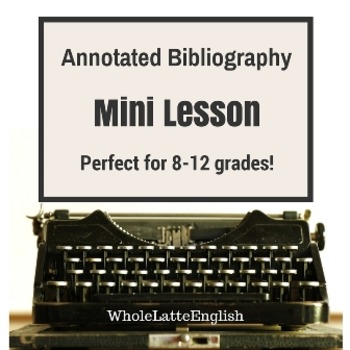Annotated Bibliography Mini Lesson
WholeLatteEnglish
88 Followers
Grade Levels
7th - 12th, Higher Education, Homeschool
Subjects
Resource Type
Standards
CCSSW.9-10.7
CCSSW.9-10.8
CCSSW.9-10.9
CCSSW.11-12.7
CCSSW.11-12.8
Formats Included
- Zip
WholeLatteEnglish
88 Followers
What educators are saying
I used this resource along with another to add some information that was not fully complete. It did well to fill in the gaps.
I needed something quick and useful to review annotated bibliographies with my Eng 101 class. This fit the bill! Thanks!
Description
An introduction to the annotated bibliography that will provide your students with an overview of the annotated bibliography as well as opportunity to practice what they learned.
Mini Lesson Includes:
- Introductory PowerPoint that gives students an overview of the annotated bibliography including its purpose, an example, and needed materials *NOTE: This is a PowerPoint SlideShow and cannot be edited
- Guided Notes Sheet for students to use during the PowerPoint lecture
- Research question and links to sources for students to use during guided practice
- Peer editing sheet for informal assessment
Total Pages
Answer Key
N/A
Teaching Duration
1 hour
Report this resource to TPT
Reported resources will be reviewed by our team. Report this resource to let us know if this resource violates TPT’s content guidelines.
Standards
to see state-specific standards (only available in the US).
CCSSW.9-10.7
Conduct short as well as more sustained research projects to answer a question (including a self-generated question) or solve a problem; narrow or broaden the inquiry when appropriate; synthesize multiple sources on the subject, demonstrating understanding of the subject under investigation.
CCSSW.9-10.8
Gather relevant information from multiple authoritative print and digital sources, using advanced searches effectively; assess the usefulness of each source in answering the research question; integrate information into the text selectively to maintain the flow of ideas, avoiding plagiarism and following a standard format for citation.
CCSSW.9-10.9
Draw evidence from literary or informational texts to support analysis, reflection, and research.
CCSSW.11-12.7
Conduct short as well as more sustained research projects to answer a question (including a self-generated question) or solve a problem; narrow or broaden the inquiry when appropriate; synthesize multiple sources on the subject, demonstrating understanding of the subject under investigation.
CCSSW.11-12.8
Gather relevant information from multiple authoritative print and digital sources, using advanced searches effectively; assess the strengths and limitations of each source in terms of the task, purpose, and audience; integrate information into the text selectively to maintain the flow of ideas, avoiding plagiarism and overreliance on any one source and following a standard format for citation.


